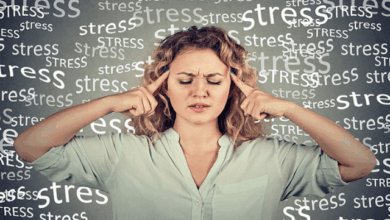Boost your mental wellbeing through simple habits

Life feels…fast. Overwhelming, even. We’re constantly bombarded with notifications, to-do lists, and the pressure to do more. It’s easy to get caught up in the whirlwind and forget to simply be. But what if I told you there was a way to find a little more peace, a little more calm, amidst the chaos? It’s not about escaping life, but about changing how you experience it. That’s where mindfulness comes in. It sounds a bit “woo-woo” maybe, but trust me, it’s incredibly practical. This isn’t about hours of meditation (though that’s great if you enjoy it!). It’s about weaving small moments of awareness into your everyday routine. We’ll explore simple habits you can start today to boost your mental wellbeing and rediscover the joy in the present moment. From mindful eating to noticing your breath, we’ll cover practical techniques to help you navigate life with more ease and less stress. It’s about cultivating a kinder, more compassionate relationship with yourself and the world around you.
Key Takeaways
- Mindfulness is about presence: Focusing on the “now” without judgment.
- Simple habits make a difference: You don’t need to meditate for hours to experience benefits.
- Mindful breathing is a powerful tool: A quick way to center yourself in moments of stress.
- Mindful eating enhances enjoyment: Savoring your food improves digestion and satisfaction.
- Body scan meditations promote relaxation: Bringing awareness to physical sensations.
- Gratitude practices boost happiness: Focusing on the good things in your life.
- Mindful walking connects you to your surroundings: Paying attention to the sensations of movement.
What Exactly Is Mindfulness?
At its core, mindfulness is paying attention – on purpose, in the present moment, and without judgment. It’s about observing your thoughts, feelings, and sensations as they arise, without getting carried away by them. Think of your thoughts like clouds passing in the sky. You notice them, but you don’t need to jump on board and go for a ride. This isn’t about clearing your mind (that’s nearly impossible!), but about learning to relate to your thoughts differently. Many people find that regular mindfulness practice helps reduce anxiety, improve focus, and increase self-awareness. It’s a skill that takes practice, but the rewards are well worth the effort. It’s a way to step out of autopilot and truly experience your life.
Mindful Breathing: Your Instant Reset Button
One of the easiest and most accessible ways to practice mindfulness is through your breath. You’re already doing it, all day long! The trick is to notice it. Find a comfortable position, close your eyes if you like, and simply bring your attention to the sensation of your breath entering and leaving your body. Notice the rise and fall of your chest or abdomen. Feel the air passing through your nostrils. When your mind wanders (and it will!), gently redirect your attention back to your breath. There are many different breathing exercises you can try, like box breathing (inhale for 4, hold for 4, exhale for 4, hold for 4), but even a few moments of simple breath awareness can make a big difference. This technique is incredibly helpful for managing stress and anxiety, and can be done anywhere, anytime.
Mindful Eating: Savoring Every Bite
How often do you eat on the go, distracted by your phone or the TV? Mindful eating is about slowing down and truly savoring your food. Before you take a bite, take a moment to appreciate the colors, textures, and aromas. Chew your food slowly and deliberately, paying attention to the flavors and sensations. Notice how your body feels as you eat. Are you truly hungry? Are you enjoying the food? Mindful eating can help you develop a healthier relationship with food, improve digestion, and increase your overall enjoyment of meals. It’s about turning eating into a nourishing experience, rather than just a quick fuel stop.
The Power of Body Scan Meditations
A body scan meditation involves bringing your attention to different parts of your body, one at a time. Start with your toes and gradually work your way up to the top of your head. Notice any sensations you experience – warmth, coolness, tingling, pressure, or even nothing at all. There’s no right or wrong way to feel. The goal is simply to observe your sensations without judgment. Body scan meditations can help you become more aware of your body, release tension, and promote relaxation. You can find guided body scan meditations online or through mindfulness apps.
Cultivating Gratitude: A Simple Path to Happiness
Gratitude is a powerful emotion that can significantly boost your mental wellbeing. Taking the time to appreciate the good things in your life, no matter how small, can shift your perspective and increase your overall happiness. Keep a gratitude journal and write down a few things you’re grateful for each day. Or, simply take a few moments each evening to reflect on the positive aspects of your day. Expressing gratitude to others can also strengthen your relationships and foster a sense of connection. Practicing gratitude is a simple yet effective way to cultivate a more positive outlook on life.
Mindful Walking: Connecting with Your Surroundings
Walking is a great form of exercise, but it can also be a powerful mindfulness practice. Instead of getting lost in your thoughts, pay attention to the sensations of walking. Notice the feeling of your feet on the ground, the movement of your body, and the air on your skin. Engage your senses – look around and appreciate the sights, sounds, and smells of your surroundings. Mindful walking can help you connect with your body, reduce stress, and appreciate the beauty of the present moment.
Mindfulness and Technology: Finding Balance
It’s ironic that in a world designed to connect us, technology can often leave us feeling more disconnected. Be mindful of your technology use. Set boundaries for yourself – turn off notifications, schedule tech-free time, and be intentional about how you spend your time online. Instead of mindlessly scrolling through social media, use technology to support your wellbeing – listen to a guided meditation, read an inspiring article, or connect with loved ones.
Dealing with Difficult Emotions Mindfully
Mindfulness isn’t about suppressing difficult emotions; it’s about learning to relate to them in a healthier way. When you’re feeling overwhelmed, anxious, or sad, try to observe your emotions without judgment. Notice the physical sensations associated with your emotions – a racing heart, a tight chest, or a knot in your stomach. Acknowledge your emotions without getting carried away by them. Remember that emotions are temporary and will eventually pass.
Mindfulness for Better Sleep
Struggling to fall asleep? Mindfulness can help. Before bed, try a short body scan meditation or a guided sleep meditation. Focus on relaxing your body and calming your mind. Avoid screen time for at least an hour before bed. Create a relaxing bedtime routine that signals to your body that it’s time to sleep.
Incorporating Mindfulness into Your Workday
Work can be a major source of stress. Bring mindfulness into your workday by taking short breaks to practice mindful breathing or stretching. Pay attention to your posture and body language. Be present in your meetings and conversations. Avoid multitasking and focus on one task at a time.
Mindfulness and Self-Compassion: Being Kind to Yourself
Mindfulness and self-compassion go hand in hand. Self-compassion is about treating yourself with the same kindness and understanding that you would offer to a friend. When you’re struggling, remind yourself that everyone makes mistakes and that it’s okay to not be perfect. Practice self-care and prioritize your wellbeing.
Overcoming Common Challenges to Mindfulness
It’s normal to encounter challenges when you first start practicing mindfulness. Your mind will wander, you’ll get distracted, and you might feel frustrated. Don’t give up! Be patient with yourself and remember that mindfulness is a skill that takes practice. Start small and gradually increase the duration of your practice.
Resources for Further Exploration
There are many excellent resources available to help you deepen your mindfulness practice. Apps like Headspace and Calm offer guided meditations and mindfulness exercises. Books like “Wherever You Go, There You Are” by Jon Kabat-Zinn provide a deeper understanding of mindfulness principles.
Making Mindfulness a Lifelong Practice
Mindfulness isn’t a quick fix; it’s a lifelong practice. The more you practice, the more natural it will become. Integrate mindfulness into your daily routine and make it a habit. Be patient with yourself, and remember that even a few moments of mindfulness each day can make a significant difference in your mental wellbeing.
FAQs
Q: Is mindfulness the same as meditation?
A: Not exactly. Meditation is a practice that often incorporates mindfulness, but mindfulness itself is a state of being – paying attention to the present moment. You can be mindful without formally meditating.
Q: How long do I need to practice mindfulness to see results?
A: Even a few minutes a day can be beneficial. Consistency is key. You might notice subtle shifts in your awareness and stress levels within a week or two, with more significant benefits over time.
Q: What if my mind is always racing?
A: That’s perfectly normal! The goal isn’t to stop your thoughts, but to observe them without getting caught up in them. Gently redirect your attention back to your breath or chosen focus whenever your mind wanders.
Q: Can mindfulness help with anxiety?
A: Yes, practicing mindfulness in daily life can be a very effective tool for managing anxiety. It helps you become more aware of your anxious thoughts and feelings without judgment, reducing their power over you.
Q: I’ve tried mindfulness before and it didn’t work for me. Should I give up?
A: Not necessarily! There are many different ways to practice mindfulness. Perhaps try a different technique, a different app, or a different time of day. It might take some experimentation to find what works best for you.
We hope this guide has inspired you to explore the benefits of practicing mindfulness in daily life. Remember, it’s not about perfection, it’s about progress. Start small, be kind to yourself, and enjoy the journey! We’d love to hear about your experiences – feel free to share your thoughts and questions in the comments below. And if you found this helpful, please share it with your friends and family!
Hi, I’m Sophia! Welcome to my blog Try Stress Management (trystressmanagement.com), where I share simple, down-to-earth ways to handle stress and bring more calm into everyday life. Think of me as your friendly guide, offering practical tips, reflections, and little reminders that we’re all figuring this out together.
When I’m not blogging, you’ll usually find me with a good book, sipping tea, or exploring new walking trails. I believe small changes can make a big difference—and that a calmer, happier life is possible for everyone.




